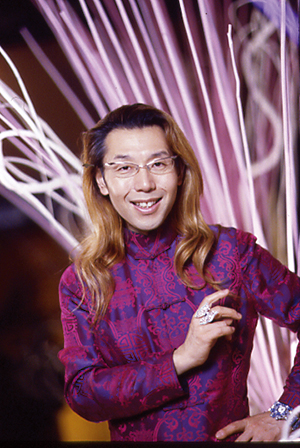 With his lavish silk mandarin jackets and trademark long blond locks of hair, celebrated flower arranger Shogo Kariyazaki looks for all intents and purposes to be the embodiment of his own maxim, ヤbeauty begets beautyユ.
With his lavish silk mandarin jackets and trademark long blond locks of hair, celebrated flower arranger Shogo Kariyazaki looks for all intents and purposes to be the embodiment of his own maxim, ヤbeauty begets beautyユ.
And yet this self-proclaimed badge of honor was fostered long before he made regular appearances on TV chat shows, giggling coquettishly and taking potshots at his own masculinity. It was even concocted some time before Kariyazaki sashayed the globe producing the floral masterpieces heユs renowned for.
In fact beauty first found Kariyazaki as a child in the northern suburbs of Tokyo and took hold. Itユs the reason the revered floral guru wasnユt on the baseball field with the other boys when he was younger. Itユs the reason that today, aged 48, Kariyazaki and beauty are synonymous, seamlessly so inextricably coupled in a marriage of aesthetic symbiosis.
My parents have always loved gardening and as a young boy I used to help my parents in the garden,says Kariyazaki as he takes a short break from his hectic schedule to talk to us during the seventh installment of his annual flower exhibition at Meguro Gajoen, Tokyo, in November last year. I was known as engei shonen (a gardening boy). I thought flowers were beautiful and I’ve been surrounded by flowers ever since. I began to understand a lot about flowers from my parents and during my high school and university years I grew flowers as a hobby. At university I was thinking about my future and what Iユd do once I graduated, and I wondered how I could give meaning to the flowers I was growing. It was then my interest changed from merely growing flowers to arranging them and I decided to go to ikebana school.
These days ikebana is venerated as one of the traditional arts in Japan along with calligraphy and the tea ceremony. The practice dates back to the sixth century when ritual flower offerings were made in Buddhist temples, the flowers and branches of which were arranged to point towards heaven as a testament of faith. Ikebana has undergone a number of changes over the centuries, with the modern style being far more expressive than its classic counterpart. The most significant shift came about during the 15th century when the rules of ikebana were simplified so that the art would transcend social and class divides, a move that allowed it to be enjoyed and appreciated by all.
History, thus, suggests this classic tradition is perhaps in a constant, albeit reverential, state of flux. In other words, ikebana is continuously evolving, a trend that can only benefit from the vision and commercial popularity of progressive floral artisans such as Kariyazaki.
[Ikebana] is really free,Kariyazaki says. It ユs free because itユs self-expression. There are no restrictions. In mathematics one plus one will always equal two but with flowers the answer is infinite, you can do whatever you want with the only proviso being it must be beautiful. Beauty has power. In the beginning my arrangements were far more minimal than now, but gradually my style became more gorgeous and I experimented with designs that were both opulent and telling. In addition, I began to feature the concepts of wabi and sabi in my art and my style became more and more varied the more experiences I had as an individual.
I only knew one way in the beginning but now the possibilities for my art are forever expanding. Now I can express different worlds and perspectives.
Even a rudimentary comprehension of the uniquely Japanese aesthetic known as wabi sabi will help the uninitiated begin to unlock some of the hidden meaning and mystery in some of Kariyazakiユs designs, taking them one step closer to achieving a total understanding of the subtle nuances of his art.
In a book entitled Wabi-Sabi: For Artists, Designers, Poets & Philosophers, author Leonard Koren says wabi sabi can be conceptualized as representing a comprehensive Japanese aesthetic centered on the acceptance of transience. This Japanese view of the world is one that regards beauty as imperfect, impermanent and incomplete.
Fellow author and wabi sabi guru Richard R. Powell agrees. [Wabi sabi] nurtures all that is authentic by acknowledging three simple realities: nothing lasts, nothing is finished and nothing is perfect.
Although a literal translation of the words wabi and sabi is nigh on impossible, the word wabi tends to connote notions of rustic simplicity, freshness, quietness or understated elegance. Sabi, on the other hand, imparts sentiments of beauty or serenity that come with age: the life of an object and its permanence are reflected in its patina and wear. In its totality, the wabi sabi aesthetic is one that arouses a sense of somber longing, a melancholy ache or hopeful sadness that recognizes and appreciates that nothing lasts, nothing is finished and nothing is perfect. Although these sentiments are universal, wabi sabi as an ideology is intrinsically specific to the culture it serves, a fact not prohibiting non-Japanese from appreciating traditional ikebana and its own wabi sabi constructs, as Kariyazaki himself explains.
メIkebana is a traditional facet of Japanese culture but its popularity has already spread over the world,he says. The word ikebana is respected as a proper noun and although the art form is very mysterious it is in fact welcoming and encourages people to express themselves. Nature gives birth to the flower. This flower is already a completed work of beauty, but we recreate a new beauty that everyone can enjoy. Although ikebana was born in Japan, lots of people all over the world appreciate flowers and although there are some fundamental differences between Western flower arrangement and Japanese ikebana arranging styles, for example, are more decorative in the West and more cosmic in Japan the line between the different schools of thought is becoming increasingly blurred. As an artist I visit many different places and understand the importance of learning about different worlds. Space, flower, material, vase, person ミ these are the necessary elements for ikebana or flower arrangement. There are suitable flowers for foreign spaces and there are flowers for Japanese spaces. However ikebana is free. Ikebana is changing so that everyone can enjoy this form of self-expression. It all depends on peoplesユ awareness. It depends on their interest.
Years of training and more than a modicum of creative genius have made Kariyazaki a household name in Japan. His resume boasts countless accomplishments, including floral decorations for the ceremony welcoming former US President Bill Clinton to Japan when he was in office, adornments to mark the 10th anniversary of the Japanese emperorユs ascension to the throne, numerous best-selling books and an annual exhibition at Meguro Gajoen attracting more than 40,000 visitors each year. In his exhibition, Kariyazaki decorates each room in the illustrious Hyakudan Kaidan (One Hundred Step Staircase) banqueting hall to fit and enhance the varying atmospheres of each space.
But instead of adopting a holier-than-thou attitude, Kariyazaki is quick to encourage complete novices to give ikebana a go. He even has some handy hints for those looking to dabble for the first time in the New Year.
For starters, you should just try it, he says. メWhy not arrange flowers for your bathroom, for your bedroom, living room or entrance? Not only will you appreciate it, your guests are sure to remark: ヤOh, how beautiful!ユ Thatユs the beginning and from there you may choose to go deeper into the art. Some might choose to study it; others may just go about arranging flowers in their own way. But whichever path is selected, the important thing is to enjoy what you are doing.
メOver the New Year, choose colors that reflect the season (red, white, gold or silver). When choosing a vase, select something demure made from Japanese pottery or something bright and colorful if you prefer. Seasonal flowers and imported species can be bought all year round and if you focus on a specific color it can be easier to express the atmosphere surrounding New Year holidays.
メAnother method of adding a seasonal ambience to your arrangements is to use different kinds of seasonally specific knick-knacks. During the New Year holidays, for example, you could use red and white washi (traditional Japanese paper) or washi with mizuhiki.
Mizuhiki is a ribbon-like paper cord cut into long thin strips that have been twisted into string then covered with glue made of seaweed and white clay to make stiff. It is from this process that mizuhiki gets its name: mizu, meaning water, and hiki, meaning to apply. After the cord is formed it is polished to a shine with a cotton cloth or wrapped with colored silk or thin metallic paper to create hundreds of beautiful color combinations. When offered as a gift, mizuhiki is said to connect the hearts of the giver and receiver.
While beautiful arrangements are likely to receive the most positive feedback, Kariyazaki notes that one should also remember practical considerations.
メUse the flowers you like,he says. It ユs interesting to note that demure colors have been particularly popular recently. I also suggest people use green leaves they last a long time and are probably more economical.
As far as the magnanimous Kariyazaki is concerned, ikebana does not stand alone as an art form. Flowers are an intrinsic part of numerous art forms, so much so that collaboration with other creators is a logical step forward for him and his craft.
There are many arts connected with flowers,he says. For example thereユs fashion, literature, painting, music, cooking, architecture and so on. I want to collaborate with all of these art forms and traditions.
Also I love music very much and Iユd like to perform my art alongside other musicians on stage. Recently I worked with pianist Fujiko Hemming, guitarist Kaori Muraji and cellist Nobuo Furukawa. Iユve also collaborated with Mansai Nomura who performs noh and kyogen (Japanese theater). I want to work with many more artists and experience more and more inspirational things.
Kariyazakiユs future seems to know no bounds, which is perhaps a direct result of the same beauty that captured his imagination as a young boy and continues to power his progress in a beautiful process of symbiosis. Yet rather than etching his name in history, heユd much prefer to leave flowers.
Beauty osmoses into my cells and this has become the basis for my work,モ he says. It ユs necessary for me to be exposed to beautiful things because I am also a creator of beauty. I’m not planning to leave my name in history and 300 years from now I hope flowers will continue to refresh and energize people. In the world we have issues of global warming, the destruction of nature and war. If the world is at peace flowers will bloom everywhere.
Story by Jon Day
From J SELECT Magazine, January 2007

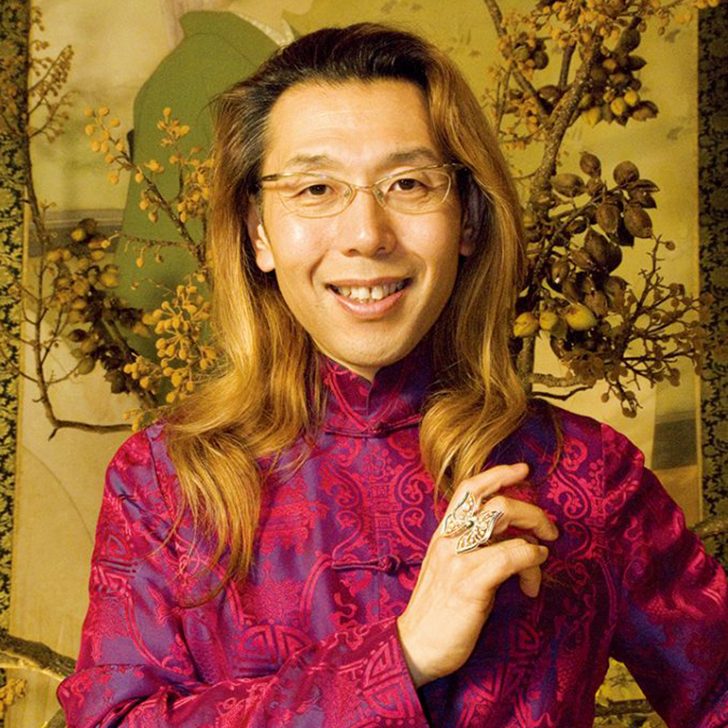


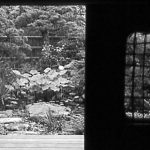

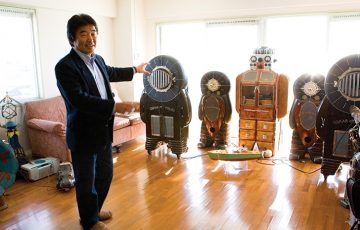
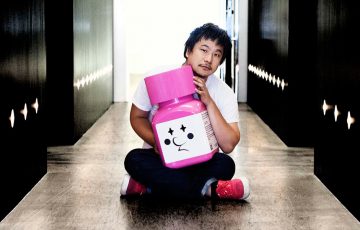
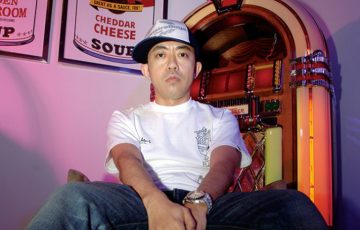
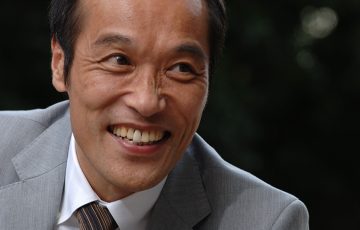
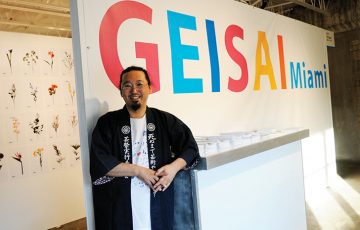




Recent Comments